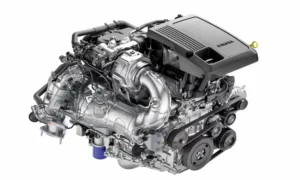If your Duramax is showing the P2463 code, you’re likely dealing with a Diesel Particulate Filter (DPF) clogged with soot. This can lead to reduced engine power and annoying warning messages. Understanding and addressing the P2463 code can help you get your vehicle running smoothly again. Curious how to fix this? Stick around to learn the steps to solve this common issue.
Symptoms of a Clogged DPF
A clogged Diesel Particulate Filter (DPF) on your Duramax can cause several noticeable issues. These include warning lights on the dashboard, reduced engine performance, and visible black smoke from the exhaust.
Warning Lights on the Dashboard
When the DPF gets clogged, you’ll likely see several warning lights on the dashboard. The most common one is the check engine light.
In some cases, you might also notice the DPF warning light, which specifically alerts you to issues with the filter. These lights serve as an early warning that soot is accumulating in the filter and needs attention.
Ignoring these warning lights can lead to more severe issues, like entering “limp mode,” where the vehicle limits its performance to prevent damage.
Reduced Engine Performance
A clogged DPF can drastically affect your engine’s performance. You’ll notice a significant drop in power, which makes it harder for your vehicle to accelerate.
You might also find that your vehicle consumes more fuel than usual. This is because the engine has to work harder to push exhaust gases through a clogged filter.
In severe cases, the vehicle may enter “limp mode,” which restricts engine power and speed to protect the engine from damage. This can be especially problematic if you’re on the highway or needing to drive long distances.
Visible Black Smoke from Exhaust
Another symptom of a clogged DPF is visible black smoke coming from the exhaust. This happens because the soot that’s supposed to be trapped in the filter is instead being expelled through the exhaust pipe.
Black smoke is a clear indicator that the DPF is not functioning properly. It’s not just a sign of a clogged filter but also an environmental concern.
Seeing black smoke means you should address the problem immediately. Continuing to drive with a clogged DPF can cause further damage to the engine and the exhaust system.
Common Causes of P2463 Code
The P2463 code on Duramax vehicles often indicates a problem with the diesel particulate filter (DPF). This code can be triggered by accumulated soot, failed regeneration processes, or issues with sensors and wiring.
Accumulated Soot and Clogging Issues
Accumulated soot is a primary reason for the P2463 code. Over time, soot builds up in the DPF, causing it to clog. When the filter is clogged, exhaust gases can’t pass through easily, leading to increased backpressure. This triggers the P2463 code. Regularly check and clean your DPF to avoid clogging issues.
Failed Regeneration Process
The DPF needs to regenerate to burn off accumulated soot. If the regeneration process fails, soot will accumulate. This can happen due to short trips that don’t allow regeneration to complete or issues with the regeneration system itself. A failed regeneration process can be a common cause of the P2463 code.
Sensor and Wiring Problems
Faulty sensors or wiring can also be culprits. The DPF relies on sensors to monitor pressure and temperature. These sensors can fail or provide incorrect readings if the wiring is damaged. When this happens, your vehicle might display the P2463 code. Regularly checking the sensor and wiring can help you avoid this issue.
Solutions and Fixes for P2463
When dealing with a P2463 code, it’s essential to understand the key methods to fix and prevent this problem from recurring. You’ll need to clean and maintain the DPF, use regeneration methods, and possibly repair or replace faulty components.
DPF Cleaning and Maintenance
A clogged DPF (Diesel Particulate Filter) can trigger the P2463 code. Regular cleaning and maintenance are crucial.
You should inspect the DPF for soot buildup. If a significant amount is present, you can perform a manual clean or use a cleaning additive to help remove the soot. It’s also important to check for any damage or wear on the DPF itself. Keeping up with regular maintenance helps prevent future blockages and extends the life of the filter. Ensuring that your vehicle’s engine and exhaust systems are in good condition minimizes the risk of DPF issues.
Manual and Active Regeneration Methods
Regeneration is the process of burning off soot that accumulates in the DPF. There are two primary methods: manual and active.
Manual regeneration involves taking your vehicle on a long drive at highway speeds. This allows the exhaust to reach high temperatures, burning off the collected soot in the DPF.
Active regeneration is a programmed process where the vehicle’s computer system initiates the burning off of soot. This process may require a specialized tool or dealership intervention. If your vehicle prompts for a service regen, it’s essential to follow through to clear the accumulated particles. Regularly engaging in either of these methods can prevent the recurrence of the P2463 code.
Repair or Replacement of Faulty Components
Sometimes, the root cause of a P2463 code lies in faulty components within the exhaust or emission system.
Begin by checking the EGR (Exhaust Gas Recirculation) valve for clogging or malfunction, as a clogged DPF can sometimes be a symptom of a failing EGR valve. The EGR cooler should also be inspected and cleaned if necessary. In some cases, you may need to replace the DPF altogether if it’s too damaged or degraded to function properly. Keeping up with these repairs ensures that the emission system runs smoothly and prevents additional issues.
Cost Considerations for P2463 Repairs
When you see the check engine light due to the P2463 code, it usually means there’s a problem with your diesel particulate filter (DPF). Addressing this issue can vary in cost depending on several factors.
Auto repair shops typically charge between $75 and $150 per hour for labor. If the DPF needs cleaning, the total cost will depend on the extent of the soot buildup.
If replacement parts are necessary, the cost might increase. Checking the filter for damage or blockage is a step you may have to pay for. The diagnosis usually takes about an hour, so you can expect labor charges for that time.
Below is a simple table outlining potential costs:
| Service Type | Estimated Cost |
|---|---|
| Labor (per hour) | $75 – $150 |
| DPF Cleaning | Depends on soot buildup |
| DPF Diagnosis (1 hour) | $75 – $150 |
Your car’s model and your location can also impact these costs. For example, prices may be higher in urban areas compared to rural ones. If you’re unsure, you might want to check multiple auto repair shops for quotes to find the best price.
Make sure to ask each shop about their hourly rates and get an estimate before any repairs. This way, you can avoid unexpected surprises on your bill.
Prevention and Long-Term Care
Caring for your Duramax vehicle’s DPF system is crucial to avoid the P2463 trouble code. Performing regular maintenance and understanding the regeneration process can significantly improve the longevity and performance of your vehicle.
Routine Checks and Vehicle Maintenance
Regularly checking and maintaining your Duramax vehicle is essential. Inspect the DPF system frequently to ensure there are no clogs or blockages. Clean or replace the air filters as needed.
Schedule oil changes based on the manufacturer’s recommendations. Using the right type of engine oil helps maintain the Powertrain Control Module’s optimal performance.
Keep an eye on fuel consumption. High fuel usage can indicate issues with the DPF or other engine components. Regularly monitor for any unusual sounds or warning lights, which might signal problems needing attention.
Understanding Regeneration Cycles
The DPF system uses two types of regeneration cycles: active regeneration and passive regeneration. Active regeneration occurs when the Powertrain Control Module starts a process to burn off soot accumulation. This usually involves temporarily increasing fuel consumption.
Passive regeneration happens naturally when driving at sustained high speeds. This reduces the need for additional fuel, thus maintaining better fuel efficiency.
Knowing when these cycles occur can help you drive in a way that supports them, minimizing soot buildup. Pay attention to the dashboard indicators that notify you when a regeneration cycle is in progress.
Tips for Enhancing DPF Lifespan and Performance
To extend the lifespan of your DPF, avoid frequent short trips, as they prevent the DPF from reaching the necessary temperature to burn off soot. Longer trips at highway speeds promote passive regeneration.
Use high-quality diesel fuel to reduce contaminants entering the DPF. Periodically perform manual regeneration processes if your vehicle allows it, ensuring the DPF is clean and functional.
Keeping your Powertrain Control Module software updated can also aid in efficient regeneration and better performance. This proactive approach helps maintain your Duramax’s fuel efficiency and overall engine health.
By following these tips, you can prevent the P2463 code and ensure your vehicle runs smoothly for years to come.















